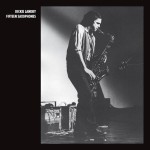Sax player Dickie Landry left south Louisiana in 1969 to push music farther than he could back home as a member of the horn section for the Swing Kings. A couple key connections landed him at the apartment of Philip Glass, who was still working on the foundations of the clumsily named “minimalism” that would shake the foundation of classical music in the ’70s and narrow the gap between it and popular culture. Landry joined the original Philip Glass Ensemble and performed on Glass’ landmark opera Einstein at the Beach at the Met, which cemented Glass’ reputation in the music world.
Landry was pushing his own musical boundaries at the time, studying flute with Arthur Lora, hobnobbing with Ornette Coleman and Laurie Anderson, and performing his groundbreaking tape delay pieces at avant-garde hotspots like The Kitchen. The three pieces appearing on his long out-of-print 1977 album Fifteen Saxophones (recently reissued by Unseen Worlds) demonstrate the delicate yet dramatic touch Landry brings to the table. “Fifteen Saxophones” takes the form of a locust swarm, small arpeggios emerging out of a synergistic hum, growing and receding with ominous mass as it proceeds. It is one man and a horn becoming a choir, resembling both Gabrieli’s antiphonal music and Ligeti’s portentous choral pieces that lent 2001: A Space Odyssey its existential anxiety.
“Alto Flute Quad Delay” bares Landry’s processes a little, but has no less an impact. Landry plays against himself through a Revox tape delay; at times it resembles the slow-cloud soundscapes of Brian Eno’s ambient work (which this album predates) while retaining the angelic cathedral paeans. One can picture Landry going from microphone to microphone around the room to create these layers as a modern music version of visiting the Stations of the Cross.
It is in the extended “Kitchen Solos” where this album finds its stride. The literally and metaphorically self-reflective environment of the delay system gives Landry a live pedestal on which to sculpt a three-dimensional portrait of the times. Drones interact with the ecstatic lyricism of Coltrane and Parker, occasionally bending toward the fiery cries of free jazz happening in New York City lofts around that time, and then receding into the architectural music of the minimalists, where the true nature of a sound is revealed through repetition.
Landry lives now on his farm in Cecilia and has since re-embraced his Louisiana roots, playing sax in the swamp pop supergroup Lil’ Band o’ Gold while exhibiting his artwork in New York and collaborating with famed choreographer Robert Wilson, (Landry worked on Wilson’s massive “1433” in Taipei last year) continually demonstrating like he does on Fifteen Saxophones that a person’s art is not dictated by a style or a place or a time period, but rather is a result of how far and in what direction that person is willing to push it.





